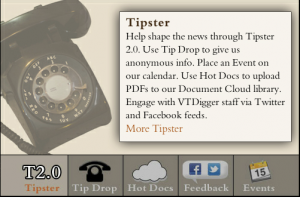Based on the final report from Founder Anne Galloway.

The new Tipster 2.0 (http://vtdigger.org/tipster/) went live on April 20, 2012, on VTDigger.org, helping to make the government, business and politics website a much more interactive experience.
Editor Anne Galloway envisioned Tipster as “a way to give readers more opportunities to shape the news,” she said in a story announcing the launch of a new de-bugged platform. The first Tipster platform was hacked repeatedly, so she came up with a new version.
Key elements of the Tipster Landing page include:
- Tip Drop, a short form to send information and story ideas that go directly to the site’s editors. Tipsters can identify themselves or remain anonymous.
- Submit a Document, a place to upload PDFs of memos, legal documents, letters and other documents to our site. Editors then archive the material on Document Cloud.
- Hot Docs, an archive of original source. It includes everything from official government reports to emails, lawsuits and memos. Readers can search the archive and download material via DocumentCloud.
- A Calendar where people can find out what’s going or on post an event on the site.
The site now has a “Report an Error” form at the bottom of every story that readers can use to let the site know about mistakes, errors and clarifications. Starting this summer, VTDigger plans to publish the corrections in a separate news feed but, until then, corrections appear at the end of stories.
VTDigger is also reaching out to readers through Facebook and Twitter with questions, polls, the backstory on issues and cool links. “We have eliminated automated posts to our Twitter and Facebook feeds, and we are using social media as our Tipster forum. We are interacting with readers about stories, press events and editorial decisions,” Galloway said.
“We are not done,” she said. “Tipster is an integral part of what we do on VTDigger.org, and we plan to continue to expand on the project.”
Future plans include incorporating SoundCloud and more DocCloud functionality. The site will create a separate Report an Error section to better notify readers of corrections. The section will include responses to reported errors and feedback from readers.
“We also plan to develop a crowdsourced FactCheck popup on story pages that will enable readers to give us feedback on whether factoids used by public figures are accurate,” Galloway said.
In its first five weeks, reader reaction to Tipster2.0 has been positive. About 588 unique readers checked out the Tipster features and the site received 23 anonymous tips and 18 calendar and event postings from users. Eight messages came in via Report an Error form in the first week of its launch. The site also received one document – a memo from the executive director of the Vermont Human Rights Commission to the Burlington School District regarding racial tensions at the high school.
So far, tips have ranged from one-line news items to critiques of policy, but some will lead to larger stories, Galloway said
“Though we have an active comment base in which readers freely criticize our work or suggest tips, we know not everyone wants to go public with information. Tipster gives readers other vehicles to communicate with us,” Galloway said.
“I recently asked our 1,572 Facebook fans if they had any questions for the governor (I was headed to his weekly press conference) and within five minutes I had three questions in hand,” she said.
She noted in her final report, “The most powerful aspect of the Tipster project is the way it is changing our work. Readers are shaping the way we report and they are shifting the power dynamic. We don’t have to decide everything — what to cover, who to call, what to ask — readers can help us make those decisions when we let them. When they tell us we make mistakes, we correct our work. When they tell us we got the story wrong, we listen. “



